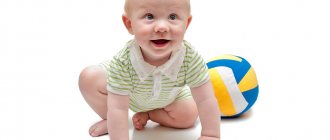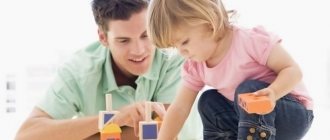Home › Child under one year old › Parenting
Author of the article
Tatyana Stanislavovna Kurtsaeva
Reading time: 6 minutes
AA
Article last updated: 11/13/2019
You need to pay attention to your baby’s development from birth. Mothers often communicate with their babies through short rhymes and songs. “Okay, okay” is the first nursery rhyme that parents remember. How and when to play it? We'll talk about this further. 5 variants of Ladushki's texts. Read poems, listen to Ladushka's songs and watch a cartoon with your baby.
A child's first acquaintance with palms
The process of learning to play takes place in several stages:
- To show your child the rules of the game, it is necessary to involve as many adult participants in the room as possible so that they demonstrate a certain movement.
- The child notices that people clap and are happy about this, and he involuntarily also wants to repeat such actions.
- To help your baby remember the movements faster, you can take his hands in yours and clap them together.
- At this time, it is recommended to recite some kind of children's poem or counting rhyme. With frequent repetition, hearing familiar words, the child will independently begin to clap his hands.
Don't worry if your baby doesn't take part in the game the first time. For him, all movements are unfamiliar and unusual. The second time you should clap your hands more slowly, taking short pauses between words. When the child already remembers the movements, he will begin to repeat them, and the new skill will begin to bring him great joy.
At first, the baby may lose his rhythm, but soon he will learn to coordinate his movements.
You should know that you should not play pat-to-let with your child when he is in a bad mood. This way he will begin to associate this game with his dissatisfaction. To make petting a truly joyful activity, cheer him up with an interesting toy or fairy tale.
Parents have played ladushki with their children since time immemorial, this game has been passed down from generation to generation - and now modern parents, playing with their baby, take his hands in theirs and begin to say: “Okay, ladushki...”
Okay. It turns out that this is not just children's fun, which causes a storm of delight among children and a sea of touching among parents! Child psychologists believe that learning this game is an important stage in a child’s development, a step in the development of his intellectual abilities, and acquaintance with the world around him.
Nursery rhymes for child development
Parents' opinions on this matter are divided. Some say that a child needs to read serious children's literature or classic works from birth. Others suggest putting off any books until a year old, citing the fact that the baby does not understand anything yet. Experts recommend starting reading rhymes from the cradle. What is the benefit of the nursery rhyme song “Okay, okay” for the development of children?
- Having fun, improving your mood. The fast, rhythmic sound of mother's voice will make the baby smile.
- Calm. Quiet and slow singing of a nursery rhyme will calm the baby down and create an atmosphere of trust and unity with the mother.
- Memory training. Over time, the child will begin to remember sounds, intonations, and then words from the song. After a year he will try to repeat the words after his mother.
- Manipulating the child’s hands while reciting the verse of the nursery rhyme song “Okay, okay” contributes to the development of coordination of movements and fine motor skills. This promotes speech development.
What kind of game is this - okay?
A primitively simple nursery rhyme is perceived by the child as an interesting activity, which is accompanied by laughter and a good mood. In fact, teaching a child to play pats and repeat the movements of adults is not so easy.
Putting your palms together and clapping them together is a super task for coordination and rhythm for an inexperienced baby. Children's specialists classify the game of palms as finger games, which are needed in order to develop fine motor skills of the hands. With the help of repeated movements, the baby will begin to feel his fingers, learn to move them consciously and consolidate the result.
The most amazing thing is that our ancestors, inventing fun and seeing how children react to it, intuitively stimulated active points on their fingertips, which increase positive energy, harmonize the psychological state, and get rid of negativity. So this is where this stormy reaction to the game, full of happy emotions, comes from!
Favorite games with the baby: palm games and finger games, nursery rhymes and jokes
Home » Articles » Child
| Administration | |
| 15.05.2013 | |
| Rating: 0 Votes: 0 | |
Today, most young mothers and fathers know about the benefits of finger games. Finger games stimulate the process of speech and mental development. This is evidenced by the research of physiologists and the experience of many generations. This page, along with finger games, contains a variety of fun games, which are also very important for the development of a child in the first years of life. This includes the “Horned Goat”, and washbasins with awakening stations, and much, much more. Our grandparents came up with a lot of interesting nursery rhymes for children, which would make dressing more fun, eating faster, and making the first steps easier. “Wake-up girls” (from birth) Pull-up, darling, Drive away the nap! (Name) get up, stand up, put your arms on your hips, cheer up, Look around - the sun is coming to visit us! Stretch and stretch! And in the legs - little walkers, And in the arms - little grabbies, Across - the fat little ones, And in the ears - the hearing little ones, And in the eyes - the little peeps, And in the nose - the small little furries, And in the mouth - the talker, And in the head - the mind! “Washers” (from birth) Water, water, Wash (name)’s face, So that the eyes shine, So that the cheeks blush, So that the mouth laughs, So that the tooth bites. While combing the girl’s hair , we say: I’ll braid my hair, I’ll braid my Russian hair. I weave, I weave, I weave. I say: You grow, grow, scythe, The whole city is beautiful! “Okay” We teach the baby to open his fists - “clap” his fists and say: (from 1 month) Views, views, views, views, beaters, I say. By 3 months we move from fist-tapping . To begin with, you can pat the baby’s palm on the mother’s hand. Clap, clap, you little palm, Clap, clap, my little one! By about 8 months, most babies are ready to play fetch on their own. But sometimes, playing “Ladushki” only when he is 1-1.5 years old. “Ladushki” (Russian folk song) - Ladushki, ladushki! - Where were you? - By Grandma. - What did you eat? - Porridge. - What did you drink? - Brazhka. The porridge is buttery, the mash is sweet, the grandmother is kind. They drank, ate, flew home, sat on their heads, and began to sing. (you can say: “They flew, they sat on their head”) (put the baby’s hands on the head) Rhymes for gymnastics Palm-elbow, Palm-elbow, Elbow-palm, Be healthy baby! (they tell the girl) Grow strong, son! (sentence to the boy) ( while stroking the hands ) Trushechki-trushechki, Grandma baked cheesecakes, Cheesecakes, little buns. (when giving a massage to a baby, you can say sentences, stroking and rubbing ) Pull the canvas, sip, put it in a box. ( For passive exercises , for example, crossing arms on the chest. If the child already knows how to sit up independently, talking about canvases, you can play the following game. Place the baby on your lap so that his legs wrap around you. Straighten your legs, keeping them slightly weight. The child should hold on to your fingers. Place the baby on your feet, and then helping him a little and pulling his arms help him return to an upright position and sit down. This is a good exercise for the back and abdominal muscles) There is such an endless fairy tale about an owl, before with which the children were told: “Listen and don’t interrupt!” An owl flew - Cheerful head . So she flew and flew, sat down on a birch tree, twirled her tail, looked around, sang a song and flew again. So she flew and flew, sat down on a birch tree, twirled her tail, looked around, sang a song and flew again. (Shall I say more?) This fairy tale is boring, of course, but kids usually really like the rhyme. Therefore, it can be used when performing various exercises during gymnastics classes, as well as for practicing on a ball (Bobass ball). The ducks swam , the ducks swam... (movement with hands) Shu, they flew and sat on their heads. (put the baby’s palms on the head) Let’s walk together When the baby takes his first steps, the adult says: “Top-top.” Big feet walked along the road: stomp-top, stomp-top. And the little legs ran along the path: tramp, tramp, tramp, tramp, tramp. “ Thump into a hole” An adult rocks a child sitting on his lap, imitating a ride over bumps, and when he says “thump,” he pretends to fall into a hole. We drove and drove, for cones, nuts, along a level path, along a level path. And then over bumps, over bumps, along narrow paths. Jump, jump, bang into the hole! I am a red fox, I am a master at running. I was running through the forest, I was chasing a bunny, and into a hole - bang! “The white-sided magpie” We move our index finger over the baby’s palm, say, bend the baby’s fingers one at a time, starting with the thumb, at the end of the joke we pull the little finger. The white-sided magpie cooked porridge and fed the children. She gave it to him, He went into the forest. She gave it to him, He chopped wood. She gave it to him, He carried water. She gave it to him, He lit the stove. But she didn’t give anything to the little one. I didn’t go into the forest, I didn’t chop wood, I didn’t carry water, I didn’t heat the stove. Eating Eating from a spoon is more fun if, while eating, an adult sings or says: Ay, lyulenki, lyulenki, the little lyulenki have arrived. The ghouls began to say, What should I feed (name)? One said: “Porridge!”, Another: “Curdled milk!”, Well, and the third: “Milk and a ruddy pie!” White-sided magpie, where was it? - Far. She cooked porridge and fed the children. She jumped on the threshold, calling guests. Hiccup joke Hiccup, hiccup, Go to Fedot, From Fedot to Yakov, From Yakov to everyone. (sometimes they add: and go away from everyone, hiccup, to the green swamp) When saying sentences, take the child in your arms facing you in an upright position. Holding him close, stroke and lightly pat the baby’s back. On a walk On a swing. There is a swing in the meadow - Up, down! Up down! (or kach-kach, kach-kach) I’ll run to swing – Up, down! Up down! (or kach-kach, kach-kach) When the baby jumps and gallops: Baba was sowing peas. Jump-jump, jump-jump! The ceiling began to spin. Jump-jump, jump-jump! The woman stood on her toes, and then on her heel, and then she went to dance merrily in a squat. Baba was sowing peas and said loudly: “Oh!” This funny joke is also a favorite for playing in the water.
If the baby is crying, don't cry, don't cry, don't cry, I'll buy you a roll. If you cry, I’ll buy a thin bast shoe! “Horned goat” The adult depicts horns with his fingers, hums and tickles the baby a little. The horned goat is walking, the butted goat is walking behind the little guys. Legs - top, top! With your eyes - clap, clap! Those who don’t eat porridge, those who don’t drink milk, are gored, gored, gored! Games with children from 1.5 years old An adult tells or sings and shows what the baby should do. A child in such a game is called, for example, a bunny, who silently repeats all the movements after the adults. Older children, for example, brothers and sisters, can also play such games with children. If there are a lot of children, then they can stand around the youngest and dance in a circle.
“Tit” The nimble tit is jumping, She can’t sit still. (jump) Jump-jump, jump-jump, Spun like a top, (wrap around yourself) Squatted down a little for a minute, (squat down) Scratched her chest with her beak (tilting her head to the right and left) And from the path to the fence, (stand up and jump) Tili-shadow, Tili-shadow. “ Zainka” Zainka, come out, little gray one, come out! This way, this way, come out! That's it, come out that way! (they show the little bunny how to go out, for example, to the middle of the circle) Little bunny, take a walk, little little bunny, take a walk! This way, this way, take a walk! This way, this way, take a walk! (several steps, first in one direction, then in the other direction) Bunny stamp your foot, little gray one stamp your foot! This way, that way, stamp your foot! Like this, stomp your foot like this! (stomp your foot several times) Bunny turn around, little gray one turn around! This way, this way, turn around! This way, turn around this way! (turn around yourself) Bunny, hands on hips, little gray, hands on hips! This way, that way, hands on hips! Like this, hands on hips! (put your hands on your waist) Little bunny, jump, little gray one, jump! This way, that way, jump! Just like that, jump like that! (jump) Little bunny, dance, little little gray one, dance! This way, this way, dance like that! Just like that, dance like that! (depict some dance movement) Bunny, bow, little gray, bow! This way, this way, bow down! This way, bow this way! (the bunny bows and the game ends) “Loaf” (a game for kids on their birthday and not only) So that the kids understand what they are playing, they should be told that a loaf is such a large round bread. One of the kids is placed in the middle of the circle, the rest take hands and dance around him, chanting: How on (child’s name) name day (or birthday) We baked a loaf! Such a height! (raise hands) Such lows! (lower your arms and bend over) This is how wide it is! (spread the circle wider) These are the dinners! (narrow the circle) Loaf, loaf, choose who you love! After the last words, the child, around whom the loaf was being danced, chooses any of the round dance leaders and changes places with him. When choosing a replacement, adults and older children may say: “I love everyone, of course, but this one (or the player’s name) more than anyone!” The game is repeated over and over again as long as there is a desire to “drive the loaf”! “ Finger games” Last but not least, in my opinion, is that children, in the process of such games, learn to show various definitions and actions with the help of gestures, to depict animals and objects. You can come up with finger games yourself by reading children's poems and singing songs, try to show what horns a cow has, claws a cat has, that the cow is big and the cat is small. It’s easy to pretend that someone is sleeping or crying, and use your thumb to show how good your mood is. Kids often come up with their own finger gymnastics, for example: pressing their fingers (index fingers) on the piano keys or depicting a dancing man with their index and middle fingers. “Thumb” Squeeze the baby’s hand into a fist and raise the thumb, saying: This finger is the most important. He is with (name) if they ask: “How are you?” Loudly you will answer: “Wow!” “Salad” - We sharpen the knives, we sharpen (we move back and forth with the edges of our palms on the table) - We chop, chop the cabbage (knock with the edges of our palms on the table) - We three, three carrots (with three fists of one hand on the palm of the other) - We salt the cabbage , salt (holding our hands above the table, we make movements with our fingers, as if we were salting a salad) - We squeeze the salad, squeeze (clench and unclench our fists) - Use a spoon in a cup and stir it into your mouth “Am” (move a finger of one hand along the palm of the other and bring finger, like a spoon to your mouth) “Steamboat” “The steamboat floats along the river and it puffs like a stove: puff-puff-puff-puff” (Put your palm to your palm, raise your thumbs up. Steamboats can not only float on the table, but also meet and get acquainted.) “Top-top” - Big feet walked along the road, (we knock on the table with our right and then left palms, imitating steps) - Top-top, top-top. - And the little legs ran along the path, (we knock with all 10 fingers on the surface of the table, imitating the tramp of many small feet) - Top-top-top-top. “Lock” We fasten our hands together, finger through finger, and we get a lock. — There is a lock on the door, who could open it? - Pulled and pulled (we pull our hands in different directions without unclenching our fingers) - Twisted and twisted (twisted up and down, alternately with one or the other hand without unclenching our fingers) - Knocked and knocked (knocked the bases of our palms against each other) friend without unclenching his fingers) - Oops, the lock has opened (we separate our palms and spread our arms in different directions). “Birdhouse” We make a house with our hands above our heads - connecting our fingertips and spreading our elbows in different directions. - The beaks stick out from the birdhouse (we show the beaks by connecting the thumbs with the rest) of small starlings (putting our palms together as if we are going to draw water into them) - Beak one (we show the beak with one hand), beak two (we show the beak with the other hand) - Paw, paw (we place our hand on the table one by one with our fingers outstretched), head (we make a “lock”). - Cook and hide (we show the house above our heads or hide our hands behind our backs). “Flowers” Hold your hands in front of you, folding elbow to elbow, fingers to fingers (bud). - Flowers of unusual beauty open, (spread your fingers to the sides without lifting the base of your palm from each other) - The breeze breathes slightly, the petals sway, (fingers move as if in the wind) - It sways, it sways. (“the flower” leans in one direction or the other) - Flowers of unusual beauty close, (press your fingers together again) - They fall asleep quietly, quietly (you can fold your palms, bring them to your ear and tilt your head) “ Bear” - Like on the slide (show a gesture with your hands - slide) snow, snow (tapping movements with fingers in the air, while the hands are spread to the sides, “drawing” the slide) - And under the slide there is snow, snow (the same movements with the fingers, the hands are spread apart straight) - And a bear is sleeping under the hill (put your fists to the top of the head, as if these are the ears of a bear) - Quietly, quietly, don’t make noise! Shh (shhhhhhh with your index finger and put your finger to your mouth) “Hedgehog” - Under the birch tree, (stretch up, arms stretched up, palms “opened” like leaves and fingers spread out) on a hillock (show a gesture with your hands - a hill) - Old hedgehog (fold lock with your hands, but spread your fingers - needles) made a hole (fold your fists, hands at the elbows, twist each fist around the other hand) - And under the leaves rustle five (show five fingers) tiny (cup your palms) hedgehogs (fold your hands into a lock, spreading fingers) “Balloon” Fingers inflate the balloon, (put your palms together, blow on them) It becomes big. (we bend our fingers, our palms take the shape of a ball) The ball burst, the air came out - (clap, we fold our palms) He became thin and thin. (we raise our hands with folded palms up like a snake, we depict how the ball flies when the air comes out of it)
What are the benefits of the game?
It is important for parents to know that playing pats is not just a child’s leisure activity. This is one of the first learning activities that can give positive results now and become the foundation for the child’s future achievements. Thanks to this exercise game:
- hand motor skills develop, which gives impetus to the activation of brain activity;
- visual and speech centers develop;
- tactile communication is born - an important way of understanding the world around us;
- not only musical and rhythmic abilities are developed, but also analytical ones.
The child learns to control his hands, subordinate their actions to the thinking process, and joins in a collective activity. Also, the positive effect of hand massage is projected onto the entire body and strengthens it.
Ladushki-ladushki listen: 6 songs for kids
Listen to several versions of the nursery rhyme song performed by V. Roiz:
- Okay, okay, where were you - at grandma's...
- Okay, okay, let’s bake pancakes, knead the dough in a bowl...
- Okay, okay, grandma baked us some sweet pancakes...
- They washed their ears with soap, they washed their feet with soap, that’s how darling, darling, darling…
- Lada-Lada-Ladushki, we will play ladushki, we will invite the sun to visit us...
- Okay, okay, wash your little darlings with soap...
Reasons for nursery rhyme
But it's not only great! The game of pats is also incredibly useful for the baby:
- If we are talking about a very baby up to a year old, then this simple game helps the baby get to know himself, feel the movement of his hands, and that they can be guided
- Hand motor skills develop, and at the same time brain activity
- An understanding is born about the most important method of communication - tactile
- Rhymes to which people clap their hands develop a sense of rhythm. And hence both musical and analytical abilities
- The whole body is massaged by influencing the treatment points of the hands
- Eliminates negative energy, read more about this further
It turns out that there are good reasons to teach a toddler. But what if a 7-10 month old child doesn’t want to and doesn’t play patsy with you?
Nursery rhyme Ladushki ladushki with movements
The nursery rhyme is accompanied by only 3 simple actions:
- on the first lines of “Ladushki, ladushki, where have you been? At grandma’s, parents take the baby by the hands, “open” their palms and connect them with cotton;
- the word “fly” is indicated by raising the baby’s arms high above his head;
- singing “sat on the head,” the palms are placed on the top of the child’s head.
Depending on the variation of the verse of the nursery rhyme for kids “Ladushki-Ladushki”, you can use the following scheme of actions:
- On the stressed syllables and words of the verse, we clap our hands: “ La darlings, la darlings, where have you been?” - By Grandma. - What did you eat? - Kashku ! - What did you drink? - Brazhka !
- Sweet porridge! (we stroke the baby's tummy)
- Grandma is good! (we stroke the child’s head with his hand)
- We drank and ate... (we stroke the tummy again)
- And they flew home! (we wave the child’s arms)
Energy of palms
I was looking for a video for you. And I came across an interesting version. In which even the doctor talks about how by rubbing circles on our hands and saying “the white-sided magpie cooked porridge,” we stimulate digestion. And clapping your hands is a massage of the whole body and increases energy, harmonizes the psychological state of the body, and gets rid of negativity. Of course, I have known for a long time that there are many healing points on the hands, but somehow I did not connect them with the ancient nurturing of children. How much we still don't know. Indeed, such simple and at first glance stupid rhymes and lessons have been passed down from generation to generation and have come down to us for a reason. For those who are interested in how they influence, I recommend: It turns out that ladushki is not just a game. When you clap your hands, you are performing one of the oldest rituals of communication with the higher world. Hand clapping is an ancient ritual movement that was used in the East to attract the attention of higher beings. In Japan, this movement is called “kashiwade”, and it is accompanied by rituals of worship and ceremonial events. According to Feng Shui, clapping your hands is a cleansing of space from negativity.
You need to clap so that your palms and fingers touch together (this is how children usually clap their hands). It is this gesture that will help harmonize internal and external energy flows, activate them and fill the space with new vitality. After all, our world is a world of energy and these claps help to break up the negative energies around a person.
In everyday life, clapping your hands attracts a lot of positive energy. Therefore, the saying that is said while clapping is very important. They say that if you make a wish at the moment of clapping, it will come true. What else is worth noting is that in the original version, the grandmother drank not mash, but yogurt. To be honest, I was always outraged by the daily mention of drinking brew at my grandmother’s. But it turns out that it was not in vain that he was outraged.
Another positive version of Ladushki, which is accompanied by the saying of wishing goodness and strength to the whole family.
How to play pats with your child?
The first thing to do is create an atmosphere. Smile at your Miracle! Emotions are contagious. The baby remembers them in the future, and associates the activities with them.
Second, create the conditions. To prevent the baby from being capricious, nothing should disturb or distract him: he should be well-fed and wear comfortable clothes.
Third, make contact. Stroke the baby's hands, pay attention to them.
But now you can take the little ones’ hands in yours and clap them. Make it look like it's really cool, interesting and fun!
My friends, the main condition for ANY activity is praise!!! Praise, and your charm will understand that he is doing well. And it’s so nice to be young!











